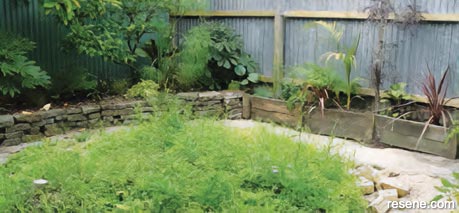From The Home Guide - your renovation and building resource
40 Ways to Stretch your Landscaping Dollar.
Reputable nurseries offer free advice and can save you from costly mistakes.
Use magazines, books and the web as resources, or enlist a green-thumbed friend’s assistance.
Make your own decisions – Keep in mind that profit motives make some landscapers overzealous.
Stick with what you want and can afford – you can always add more later.
Share bulk purchases with a friend (or combine mail-order purchases to cut down on delivery costs), and rent garden equipment with other gardeners.
Avoid impulse buying – When you visit the nursery, ask yourself: Do I really have room for these plants?
Comparison shop – Nurseries may differ in price and quality.
Self-reliant species are sometimes better buys than high-maintenance exotics.
Landscape with the mature size in mind, or you may end up paying to move oversized plants.


Test to see what your soil lacks and you won’t need to buy unneeded additives or the wrong plant.
Neutralise your soil’s pH – If it’s too acidic or alkaline, plants can’t take up nutrients, and fertilisers are wasted.
Collect manure – Some farmers give it freely. Let fresh manure age before using it or it may burn plants.
New plants need phosphorus for roots; leafing plants need nitrogen for structure; budding plants need potassium for fruiting.
Good soil is the key to healthy plants. Convert garden and kitchen refuse into humus and improve your soil’s health, aeration, and water-holding capacity.
Save on labour by leaving grass clippings on the lawn.
Buy fertiliser in bulk.
Feed lawns in autumn when growth slows and roots can store the nutrients.
Leave grass clippings where they fall to return vital nutrients to the soil, reduce the need to fertilise and eliminate composting the clippings.
Seed lawns in the autumn – There’s less likelihood of humidity-triggered diseases or hard-washing rains.
Disease and insect-resistant grasses reduce the need for lawn chemicals.
Make your own insecticide – Water mixed with 1-2 percent liquid dishwashing soap kills soft-shell insects.
Annuals will give you color all season without the price tag.
Save surplus flower seeds – In a cool, dry place, they’ll remain viable for four to five years.
Sow seeds directly in the ground, saves the outlay for potting mixtures, trays etc.
Mix annuals into your planting scheme – Perennials are an expensive investment, so purchase some of the bulk punnets of petunias and impatiens.
If you buy perennials, plant vigorous multipliers, such as daffodils or lily-of-the-valley, and in two to three years you will have three to five times as many plants.
Divide large clumps of perennials (hostas, daylilies and chrysanthemums) into several plants. Take root cuttings from easy-to-grow shrubs such as pussy willows, azaleas, and forsythia.
Select species that grow naturally in your region to avoid such costs as extra watering, pampering through winter, and soil correction.
Mulch saves the time and labour spent on weeding.
Mulch reduces watering costs, prevents erosion, provides climate protection, and improves soil.
Layer about 24 pages of newspaper in your garden bed, soak them with water then anchor them with a thin soil layer or other mulch.
Gather fallen leaves. Your garden will have a more balanced pH if you mix in a broad range of acid/alkaline leaf varieties.
Collect untreated sawdust from sawmills. It’s clean, easy to spread, and cost effective.
You’ll save $’s by buying bark by the truckload.
Wait for end of season sales – Tree planting is generally as effective in early autumn as in early spring.
Plant wind-resistant trees – Storms can cost you a huge tree-removal bill if you plant a brittle species such as silver maple.
Protect your foundations – Roots can damage concrete blocks, so plant large trees at least 10 metres from the house.
Good pruning can perform miracles on neglected shrubbery and save you the expense of replacements.
Camouflage eyesores – Plant climbing vines to hide a sagging fence or unsightly garden sheds. Check with your garden centre first to make sure you are not going to land yourself with a maintenance nightmare.
Make a septic tank goldfish pond – In most areas a septic tank bottom costs less than a fiberglass pond. Since the structure is underground, the only difference you’ll see is in the cost.
The Home Guide - your renovation and building resource
Helping you on your way to a successful and rewarding renovating experience - valuable information, tips, hints and useful checklists...